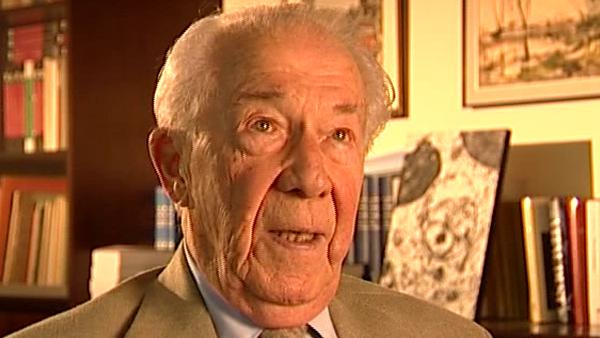NEXT STORY

'You will get a fur coat when I get a Nobel Prize'
RELATED STORIES

NEXT STORY

'You will get a fur coat when I get a Nobel Prize'
RELATED STORIES


|
Views | Duration | |
|---|---|---|---|
| 21. Writing to Carl Cori, and crystallised insulin | 206 | 03:14 | |
| 22. The Lilly Research Labs: Making a re-discovery | 203 | 03:40 | |
| 23. 'You will get a fur coat when I get a Nobel Prize' | 230 | 05:01 | |
| 24. Becoming Professor of Biochemistry at Louvain | 185 | 01:52 | |
| 25. Setting up a lab: A grant from Eli Lilly and Company | 151 | 02:40 | |
| 26. Setting up a lab: Difficulties getting equipment | 149 | 02:51 | |
| 27. Glucose 1-phosphate and glucose 6-phosphate | 187 | 03:55 | |
| 28. Purifying enzymes and visiting labs | 144 | 03:05 | |
| 29. The Rockefeller Institute and Albert Claude | 1 | 206 | 04:34 |
| 30. Centrifugal fractionation | 187 | 02:12 |


Well, in the meantime, a man called Scott... at Lilly... the Lilly Research Labs, a man called Scott had discovered a much simpler way for crystallising insulin with zinc... making crystalline insulin by a much easier method, and this method was adopted by Lilly to make their... their insulin. Lilly, or course, were the major producers of insulin in the world at that time, in the United States in particular. And without their knowledge, glucagon, which was the impurity that had been eliminated, and had, in fact, been studied by a man called Kramer in Germany... glucagon came back into crystalline insulin – that is, the zinc method of crystallising insulin did not remove glucagon – and so, unbeknownst to the experts who are using the insulin, this impurity had returned. And having read a lot about it, I came to the conclusion... because there was evidence in the literature, I came to the conclusion that this effect that Mr Bridge had found was not due to the insulin he used but to contaminating glucagon. And in the book that I wrote during the war, I even gave that as a possible explanation, but I couldn't do any research. But the day... the day we were liberated, I must say, I celebrated, but the next day I went to the American army to find an American army doctor and asked him whether he could provide me with a couple of vials of Lilly insulin. And he gave it to me; I don't know how he did, but he did. And so I went back to the lab. I still had... I had some of the Danish insulin... Novo insulin that I used... had used for my work, and so with a young man called Gerry Hers, who stayed with me all his life after that, we were still able to get a couple of rabbits, because the keeper of the physiology institute kept a few rabbits because they could be fed with the grass from the garden and they could be eaten. During the war that was quite useful. So there were rabbits, and I will always remember the day when we injected this Lilly insulin into the rabbits and got evidence of a hypoglycaemic effect. And so my first discovery was really a re-discovery... a re-discovery of glucagon, and eventually this was published and came to be known. And so what Cori was alluding to was, in fact, this re-discovery that I had made, and so I was... I was accepted and went to spend three months only... September, October, November... four months.... four months in the... the Cori lab at that time.
Belgian biochemist Christian de Duve (1917-2013) was best known for his work on understanding and categorising subcellular organelles. He won the Nobel Prize in Physiology or Medicine in 1974 for his joint discovery of lysosomes, the subcellular organelles that digest macromolecules and deal with ingested bacteria.
Title: The Lilly Research Labs: Making a re-discovery
Listeners: Peter Newmark
Peter Newmark has recently retired as Editorial Director of BioMed Central Ltd, the Open Access journal publisher. He obtained a D. Phil. from Oxford University and was originally a research biochemist at St Bartholomew's Hospital Medical School in London, but left research to become Biology Editor and then Deputy Editor of the journal Nature. He then became Managing Director of Current Biology Ltd, where he started a series of Current Opinion journals, and was founding Editor of the journal Current Biology. Subsequently he was Editorial Director for Elsevier Science London, before joining BioMed Central Ltd.
Tags: Lilly Research Labs, K J Kramer, Gerry Hers, Carl Cori
Duration: 3 minutes, 40 seconds
Date story recorded: September 2005
Date story went live: 24 January 2008